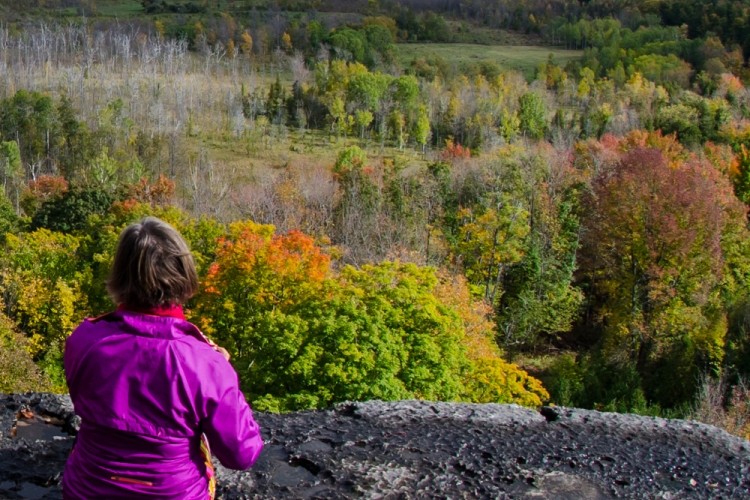Written by: Diane Liska, Registered Psychotherapist & Certified Yoga Teacher
I feel very blessed to live, work and play within the expansive and colourful landscape of Grey County. Growing up in Kincardine, I have always had a deep connection with water. And although my heart still holds a special place for the (warmer) waters of Lake Huron’s east shoreline, the felt sense of spaciousness and ease while taking in the crisp, clean air gazing across sparkling Georgian Bay has won me over. In the morning as I sip my coffee and watch the sunrise, and every evening as I drive home heading north along Grey Road 1, stress in both my mind and body dissipate across the Bay, reinforcing my gratitude and affection.
Just as my love for the landscape surrounding Georgian Bay has evolved, so too has my mindfulness practice.
There certainly is a lot of hype surrounding ‘mindfulness’ these days—and for good reason. In our quick-paced, goal-oriented society, many of us get caught up in the hustle and bustle of our day or the depths of our mind. Although there are too many specific documented benefits to list, in general, a mindfulness practice can release us from autopilot, alleviating stress-related symptoms and dis-ease in the mind and body, cultivating resilience, and creating space for goodness.

Photo: Diane Liska
As our mindfulness practice evolves, it offers the potential of improving our connection with our own lives and relationships. A regular mindfulness practice can basically give you wellness superpowers!
The key to mindfulness practice is to anchor your attention to a focal point in the present moment, notice when your mind has drifted (as it naturally will), and gently invite your attention back to your focal point, without judgement. The benefits of a mindfulness practice arise from learning to gently redirect attention over and over to the present moment—NOT reaching for stillness in the mind. Simple, but not necessarily easy: the brain too, is a muscle that requires patience and dedication to flex and grow.
As Jon Kabat-Zinn shares, any mindfulness practice has three main components:
- Paying attention on purpose
- In the present moment
- Non-judgmentally
Both professionally and personally, I prefer the beauty and accessibility of a nature-based mindfulness practice. Grey County provides an awe-inspiring array of rich colours, sounds, smells and textures throughout the four seasons. Any patch of nature that captures your senses will do, be it the sun’s rays dancing through rustling trees, a warm breeze enveloping you, or an orchestra of crickets in tangled wild flowers.
Let’s explore what a nature-based mindfulness practice might look like:
- Find a comfortable place in nature. You determine what feels most comfortable for you. HINT: the mind typically finds it easier to settle after a little movement so a short walk first may help.
- Slowly start to invite your attention to each of your five main senses, spending a minute or two in each sense to allow your awareness to unfold:
- What colours and textures do I see? In the foreground? Background?
- What sounds do I hear close to me? Further away? Can I notice the space between the sounds?
- How does this landscape/air smell or taste?
- What textures or sensations can I feel on the outside of my body? Eg. grit of sand, uneven grass, cool air on my skin, sunshine on face, where my body connects with the ground
- Now choose an ‘anchor’ (focal point) from your experience above, whatever you feel drawn to in the moment. Eg. clouds rolling across the sky.
- Invite your attention to your anchor, over and over again. The mind will naturally drift—that’s perfectly fine. When you become aware that the mind has drifted to an outside thought or image that isn’t your anchor, gently call your attention back.
- Practice with curiosity for what is unfolding in the present moment. Release any self-judgment or frustration when you catch the mind drifting. Instead, simply notice that your attention has drifted and call it back to your anchor.
- Continue as long as it feels good to you. Give yourself permission to release the practice at any time. The practice will likely feel like effort, but should not feel forced.
Similar to how the hues may deepen or sounds may sharpen throughout your nature-based mindfulness practice—life too—may start to feel more vibrant. As we learn to be truly present in the moment, we find a precious gift that lifts the veil between us and our experience: to be immersed in vitality and consciously claim the lead role in our messy, beautiful lives.
A mindfulness practice is literally in your backyard.
You don’t have to go far, but if you want to explore a little more of what Grey County has to offer, here are a few of my favourites:
- Fall foliage through Beaver Valley to Eugenia Falls Conservation Area
- Keppel Croft Gardens
- Snowshoeing trails of Pottawatomi Conservation Area
- Ainslie Wood Conservation Area
- Kemble Women’s Institute lookout
About Diane Liska
Registered Psychotherapist & Certified Yoga Teacher
With a passionate and creative spirit, Diane blends her expertise in neuroscience, psychotherapy and yoga to offer a fresh, unique, and effective approach to healing. She brings refined skill in balancing mind and body, science and intuition, and reflection and connection, to serve clients in navigating their path to wellness. Diane is particularly adept in nervous system health, healing from trauma and cultivating resiliency against burnout and/or compassion fatigue. Yes, she went to school, studied hard, and earned a bunch of fancy letters after her name—AND she still has yet to find any tool or piece of wisdom that is as powerful and healing than that of authentic connection.




